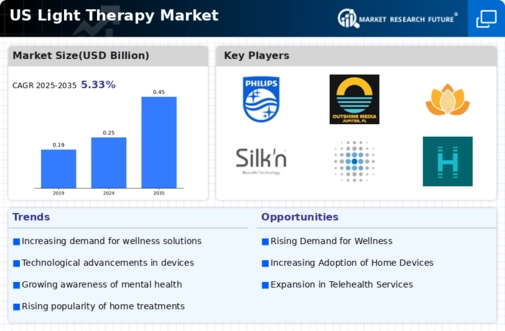Supportive Regulatory Environment
The light therapy market is benefiting from a supportive regulatory environment that encourages innovation and product development. Regulatory bodies in the US have recognized the therapeutic potential of light therapy, leading to streamlined approval processes for new devices. This favorable landscape is likely to attract investment and foster research initiatives aimed at enhancing the efficacy of light therapy solutions. Furthermore, as more products receive regulatory approval, consumer confidence in light therapy is expected to increase, driving market growth. The combination of regulatory support and ongoing research efforts may create a robust foundation for the light therapy market in the coming years.
Expansion of Home Healthcare Services
The light therapy market is experiencing a notable shift towards home healthcare solutions. As more patients prefer receiving treatment in the comfort of their homes, the demand for portable and user-friendly light therapy devices is on the rise. The US home healthcare market is projected to reach $173 billion by 2026, indicating a significant opportunity for light therapy products. This trend is further fueled by advancements in technology, which have made it easier for consumers to access effective light therapy solutions without the need for clinical visits. Consequently, the convenience and accessibility of home-based light therapy devices are likely to enhance market penetration and adoption rates.
Increased Focus on Preventive Healthcare
The light therapy market is benefiting from a broader societal shift towards preventive healthcare. As individuals become more proactive about their health, there is a growing interest in therapies that can prevent the onset of various conditions. Light therapy has been recognized for its potential to enhance mood, improve sleep quality, and alleviate symptoms of depression. This preventive approach aligns with the US healthcare system's emphasis on reducing long-term healthcare costs. With the market for preventive healthcare projected to grow significantly, light therapy is likely to gain traction as a cost-effective and non-invasive option for maintaining mental well-being.
Growing Demand for Mental Health Solutions
The increasing prevalence of mental health issues in the US has led to a growing demand for effective treatment options. Light therapy market is witnessing a surge in interest as individuals seek non-invasive alternatives to traditional therapies. According to recent data, approximately 1 in 5 adults in the US experience mental illness, which has prompted healthcare providers to explore innovative solutions. Light therapy, particularly for Seasonal Affective Disorder (SAD), has shown promising results, with studies indicating a 60% improvement rate in symptoms. This rising awareness and acceptance of light therapy as a viable treatment option are likely to drive market growth, as more individuals and healthcare professionals recognize its potential benefits.
Rising Popularity of Wellness and Self-Care Trends
The light therapy market is increasingly influenced by the rising popularity of wellness and self-care trends among consumers. As individuals prioritize mental and emotional well-being, light therapy devices are being embraced as part of holistic self-care routines. The wellness market in the US is estimated to reach $1.5 trillion by 2025, reflecting a growing consumer inclination towards products that promote health and well-being. Light therapy, with its ability to enhance mood and energy levels, fits seamlessly into this trend. As more consumers seek out innovative solutions for self-care, the light therapy market is poised for substantial growth.






















Leave a Comment